If you own an online store, you know how important it is to reach customers worldwide. Expanding your market beyond your country can significantly boost your sales and revenue. One effective way to achieve this is by creating a multilingual website for your Shopify store. A multilingual website enables you to provide content in different languages, catering to customers’ preferences from various regions. In this article, we will explore the benefits of having a multilingual Shopify site and guide you through setting it up.
What is a Multilingual Shopify Store?
A multilingual Shopify store is an online store that offers content in multiple languages. You can translate your store content into different languages, such as product descriptions, checkout processes, and customer support. This ensures customers from different regions can access your store content in their preferred language, providing them with a seamless and personalized shopping experience.
Customers are more likely to shop from a store that provides content in their native language, as it eliminates language barriers and enhances their understanding of product details, pricing, and shipping information. Translating your store content into multiple languages also allows you to adapt your app, translation app, or any translated content according to your target audience’s specific language and cultural preferences.
What Are the Advantages of Having a Multilingual Shopify Store?
Customers visiting your store are more enjoy to stay and make a purchase if they can navigate and understand your store content easily. If your store’s default language is English, customers who speak other languages may need help browsing and shopping on your site. Now that we understand the importance of a multilingual store let’s dive into its advantages to your business.
Enhancing User Experience
By offering content in multiple languages, you can significantly enhance user experience. For instance, if you have customers from different parts of the world who speak different languages, creating a multilingual site will help you cater to their needs. Multilingual content enables users to navigate your store in their native language, effectively improving user satisfaction. Let’s say you have a customer from France who browses your online store but can only read French. If your store is not available in French, they will have a hard time navigating it and might end up leaving your site.
Broader Market Reach
When your Shopify store is available in many languages, you can reach out to more people worldwide. This means you can sell to customers who speak different languages and live in various countries, helping your business grow by attracting more buyers. It’s like opening your store in a new place without moving there. You get to welcome more customers without spending a lot of extra money.
Adding new languages also makes your store look good to people from different places, showing them that you care about making shopping easy for them. This can make customers trust your store more and want to buy from you. Plus, when you sell in other countries, you might find new ways to make money by selling things that people in those places like. It’s an intelligent way to make your business bigger and reach out to new customers worldwide.
Improved Conversion Rates
Imagine walking into a store where all the signs, product descriptions, and the cashier spoke your language; you’d feel more comfortable buying there, right? That’s what happens with your online store. If customers can read about the products, find their way around, and buy things in their language, they’re more likely to purchase. They understand precisely what they’re buying and feel confident during checkout.
This comfort and confidence boost your store’s sales. When people shop without any language barriers, they get clarity and satisfaction. This means they stick around longer, look at more products, and are likelier to hit the “buy” button. So, by making your store accessible in many languages, you’re not just being nice—you’re also making your business more successful.
SEO Benefit
Search engines, like Google, start noticing your store more when people in different countries look for products you sell. This is because you’re using words and phrases that match exactly what people in those countries are searching for. If someone in France is searching for “best running shoes,” and your store’s French page talks about “les meilleures chaussures de course,” your store is more likely to appear in their search results.
This way, more people find your store without you having to pay for ads; they just find you naturally through their search. And since each language version of your store is set up to match what people in different countries are looking for, your store appears higher up in search results in those places. This means more clicks, more visits, and more chances for sales.
How to Translate Your Shopify Store in Easy Way?
Now, let’s go into action and translate your Shopify store. In this step, we’ll use Linguise, a Shopify translation plugin powered by AI. This perfectly integrates with Shopify and allows live editing of translations directly on your front-end. website’s
Step 1: Integrate the Shopify store with Linguise for translation
The first step is to connect your Shopify store to Linguise. To do so, you must first create a Linguise account.

To complete the registration process, you only need to provide your email and password. Additionally, you can benefit from the free trial option for one month without having to enter any credit card details.
Step 2: Add Shopify store domain
In step two, you will access the Linguise dashboard and add your Shopify store domain by completing several fields including platform, URL, language, and translation language.

Next, you need to set DNS on your hosting page. Fill in DNS with type 1 TXT and 7 CNAME after that, it will look like this on the Linguise dashboard.
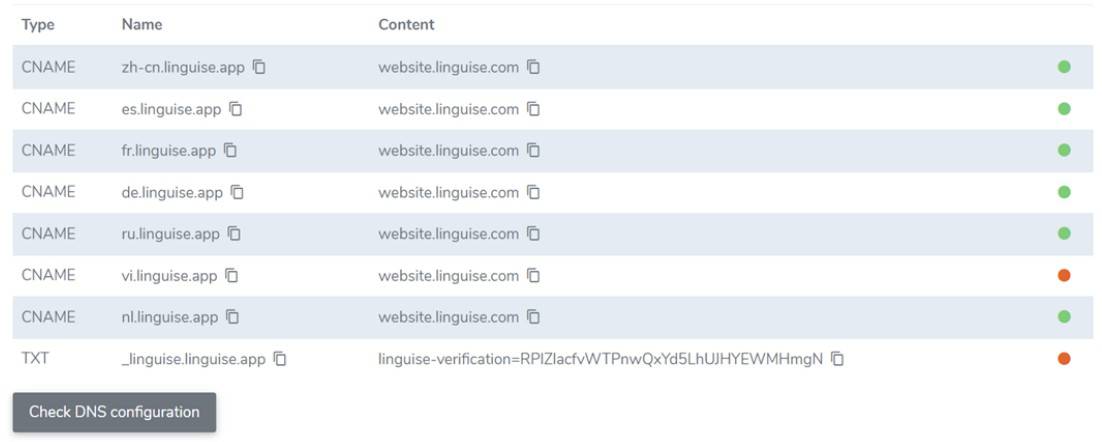
Step 3: Customizing language switcher
In the next step, we’ll use the Linguise script inserted in the Shopify theme to connect Linguise with Shopify.
Copy the script below and head to the Shopify dashboard. Select Online > Themes.
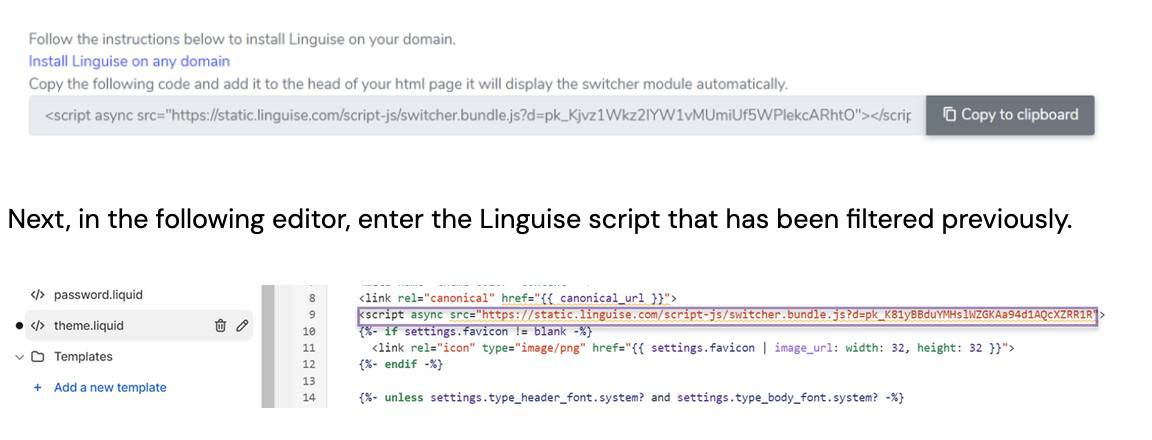
If you have connected your Linguise and Shopify stores, you will have an automatic language switcher. However, this switcher is still in its default setting. You have the option to customize it via the Linguise dashboard.
To do this, go to Settings > Language Flag Display. In this display, you can choose from several options, including the icon for the flag, the button position, and the way the display uses either the flag icon with the short name, language name, or just the flag icon. You can also choose to display language names, such as using French name displays, and set the flag box shadow to provide color, size, and shadow effect.
While customizing the language switcher, you can also preview it on the right.
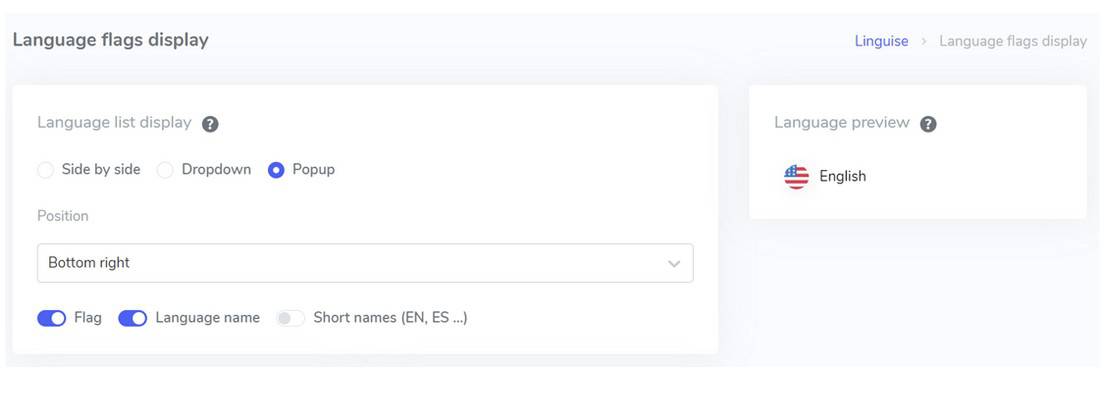
Here is what your language switcher will look like on your multi-language Shopify store after customization. It will be displayed at the bottom right of the page.
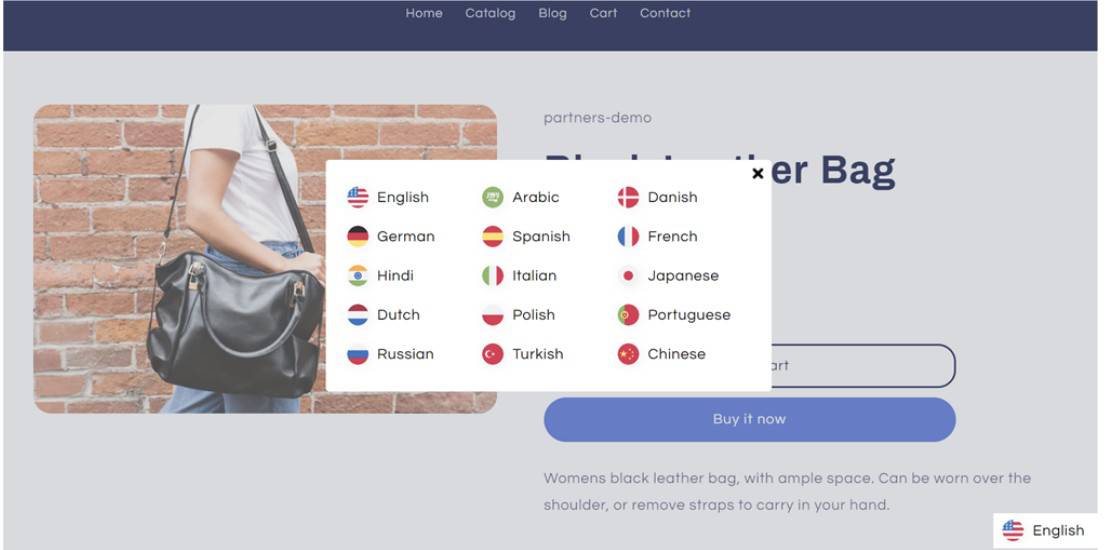
Step 4: Add and manage languages for the Shopify store
Linguise provides a dashboard with statistics on translated language presentations and visits. This helps you keep track of your website’s performance and make informed decisions about your language options.
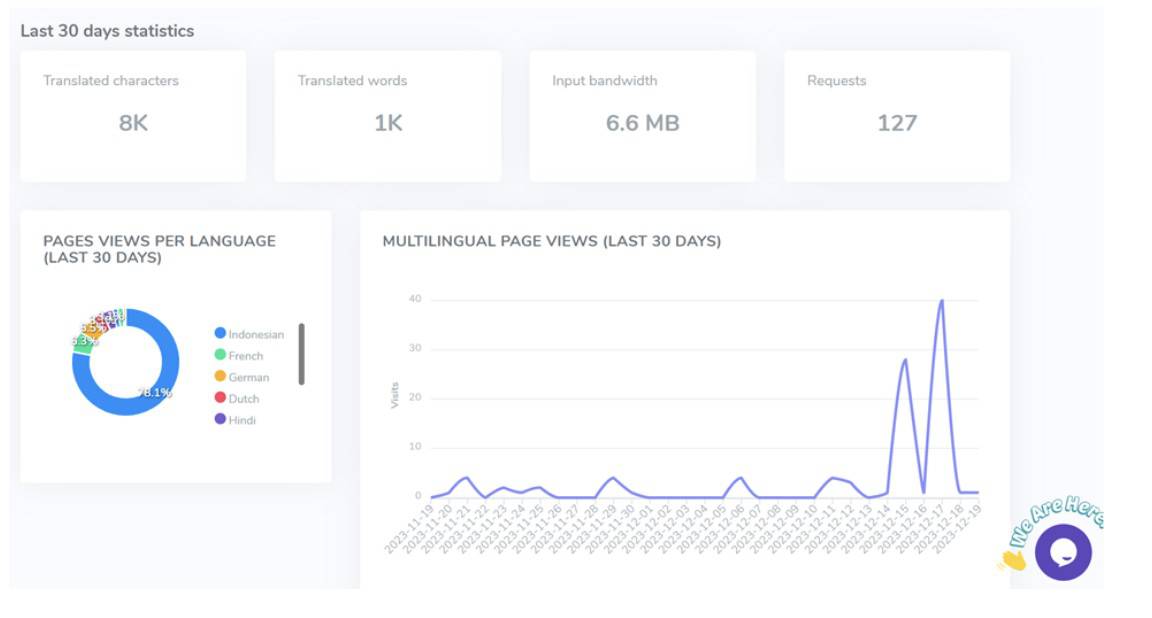
You can use the statistics to determine which language pages are most frequently visited by customers. Furthermore, you can optimize the translation of characters from each selected language, allowing you to not only create a multi-lingual Shopify store, but also maximize its potential to attract visitors from different countries and increase sales.
Tips for Maintaining a Successful Multilingual Shopify Store
After successfully translating your Shopify store, it is essential to maintain and monitor it properly. Implementing the following tips can significantly enhance the success of your multilingual Shopify store, leading to increased global sales, improved customer satisfaction, and a stronger international brand presence. Here are some key tips to help you achieve and maintain a thriving multilingual online presence:
SEO Optimization for Each Language:
Implementing multilingual SEO strategies is important to ensure your website is visible to users in different languages. One of them is using hreflang tags to indicate to search engines the language variations of your pages. This ensures that the correct version of your website shows up in search results for users in different regions. It is worth noting that if you use Linguise, the hreflang tags are automatically generated for you, so you don’t have to worry about it. Additionally, optimizing your content with language-specific keywords can further improve your website’s visibility.
Consistent Brand Messaging
Keeping your brand’s voice the same in every language is really important for making sure your customers trust you, no matter where they are in the world. When your messages sound the same in English, French, or any other language, it shows that your brand is reliable and always the same, which makes customers feel good about buying from you. It’s like making sure your store feels like home to everyone, no matter what language they speak. This way, everyone gets the same great feeling about your brand, helping you make loyal fans all over the globe.
Localize Beyond Translation
Localization means making your online store feel right at home for customers from different places. It’s not just about translating words; it’s about changing and adapt to their preferences and culture. For example, changing prices to the local currency so people know how much they’re spending, using the date formats they’re familiar with, and picking pictures that match their culture. By doing these things, you show your customers you care about and respect where they come from. This makes them happier and more likely to stick with your brand because it feels friendly and familiar, helping your store stand out worldwide.
Regularly Update and Review Translations:
Languages are always changing, with new words and phrases becoming popular all the time. Because of this, the content on your website can quickly become outdated if it’s not regularly checked and updated. It’s important to go through your translations often to make sure they still make sense and are correct. This keeps your website fresh and ensures that your message is clear to everyone, no matter when they visit. Plus, updating your content can help your website rank better in search engine results, bringing in more visitors. By staying on top of these changes, you show your customers that you’re committed to providing them with accurate and up-to-date information, making your site more trustworthy and reliable.
User-Friendly Language Switcher
Adding a language switcher to your store that’s easy to find will help your customers. It lets them choose their preferred language quickly, without having to search around, making shopping with you a smooth experience. This small but powerful feature can make a big difference in how comfortable customers feel on your site, encouraging them to stay longer and explore more. It shows you care about their needs, making your store more welcoming to people worldwide.
Customer Support in Multiple Languages
Providing customer support in the same languages as your store shows you value your customers’ comfort and needs. Having options like live chat, email support, or even a FAQ section in multiple languages makes it easier for shoppers who speak other languages to get help when they need it. This kind of support can really improve their shopping experience, making them feel more at ease and supported throughout their purchase journey. It’s a way to show that you’re not just about selling products but also about offering help and guidance in a language they understand best, creating a more inclusive and welcoming shopping environment for everyone.
Conclusion
Expanding your market reach is crucial for the growth and success of your Shopify store. With a multilingual Shopify site, you can connect with customers from different regions and cater to their language preferences. By offering a seamless user experience in their native language, you build trust and increase customer engagement. Translating your store content also ensures that your products and descriptions are accurately presented to a global audience. Whether you choose manual or automated translations, it’s important to regularly update and maintain your multilingual store to provide the best experience. So, is your Shopify store ready to go global? Start implementing these strategies and watch your business thrive in the international market.
I used to write about games but now work on web development topics at WebFactory Ltd. I’ve studied e-commerce and internet advertising, and I’m skilled in WordPress and social media. I like design, marketing, and economics. Even though I’ve changed my job focus, I still play games for fun.
Where Should We Send
Your WordPress Deals & Discounts?
Subscribe to Our Newsletter and Get Your First Deal Delivered Instant to Your Email Inbox.
Thank you for subscribing.
Something went wrong.
Keep reading the article at WP Newsify. The article was originally written by Lucija on 2024-02-12 04:14:35.
The article was hand-picked and curated for you by the Editorial Team of WP Archives.

